Part Two: How I built my own E-bike for 1/5 the cost of a buying new, and got a better bike in the process
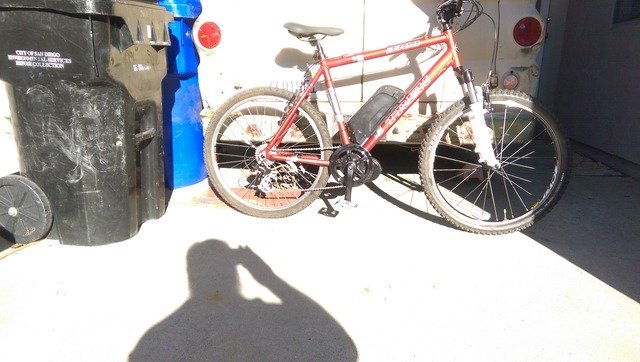
In part one, I talked about my needs vs. desires, and about the cost of quality E-bikes being out of my budget range. In this story, I will show you my rationale, give you links to vendors, and show you how I built my bike.
The goal here is to get out of my car as much as possible, and get my commute and most errands done on the e-bike, plus have a little fun, and I am a big guy, so the bike needed to be robust, able to carry my 245Lb carcass, and a weeks groceries. I decided that to meet those goals, I needed a quality bike, with beefy tires, unlike my road bike, and since I live in a hilly city, San Diego, CA. A powerful electric drive that would get me over hills without injury to my gimped up knee and back.
Types of E-bikes
A little explanation. There are 3 main types of E-bikes:
Gearless hub motors: The first type used, Very heavy system with magnets mounted in a large hub, that spins with the wheel. PROs are cheap and powerful, plus can regenerate power on downhills. CONs are heavy, large, and all the weight is concentrated at the end of the bike. These come on either a front or back rim. They also "Cog", which causes drag when not running.
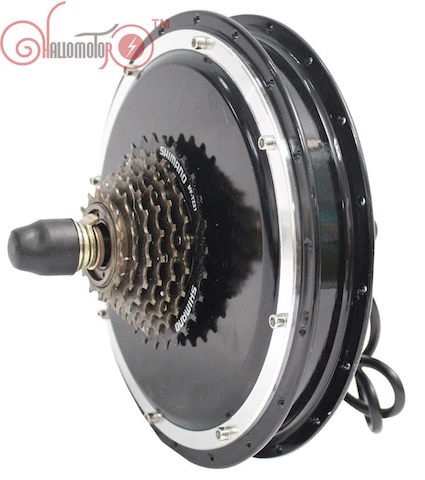
Geared Hub motors: Geared hub motors are similar to the above, but are designed with a motor in the middle that is geared to spin at a higher RPM than the wheel, and have a Planetary gear setup to reduce the speed and power your wheel. These are also mounted on the ends of the bike. PROs are cheap and powerful, more "stealthy looking" than a gearless hub, are lighter than Gearless hubs, and are newer technology with a better power to weight ratio. CONs are that they are prone to burning out on hills and under heavy loads, the weight is out on the ends of your bike.
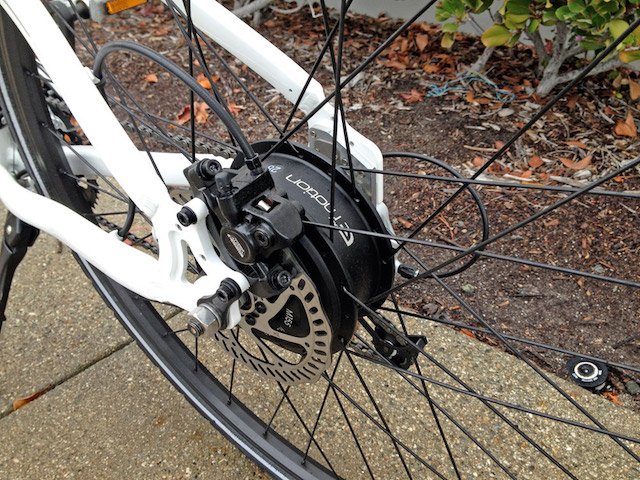
Mid Drive motors: Mid drive is the latest technology. Basically you use a motor to power the front sprocket/chain ring of the bike, using the bike's drivetrain to power the back wheel via the existing chain and rear wheel drive cluster. This puts the motor either in/on the bottom bracket, or above the bottom bracket of the bike. PROs, Using the drivetrain of the bike gives you a gearing advantage over hub motors, Weight is down low and dead center on the bike, for better handling, Built in controllers make these a simple package to install with less wiring and parts to strap onto a bike. CONs, most expensive type, no capability of regeneration, Loss of multiple chain rings on the cranks, you lose some clearance at the Bottom Bracket.
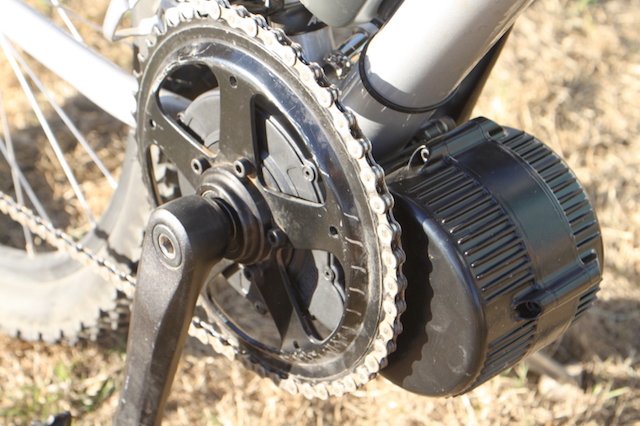
A word about electricity
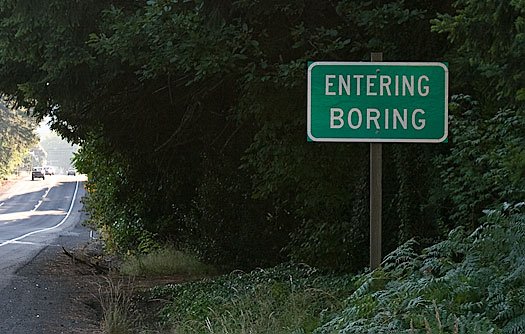
Ohm's law states that the current through a conductor between two points is directly proportional to the voltage across the two points. ... Wut??? Ok... Ohm's Law really says, “current equals voltage divided by resistance”. I=V/R
12 volts divided by 12 ohms is one amp. (V/R = I) But what does that mean when it comes to getting my bike up a big hill? A lot, really, but manufacturers try to hide the math that gets you up the hill, so a basic understanding of that equation is important. You can read a LOT more about it here.
Think of it this way, you are converting electricity into movement, and you want the most power(watts) for your buck, and the farthest range(amps) for your ride. But the saying goes "you can have cheap, powerful or long range, pick two"...
So my decision was that I needed at least a 500 watt motor that could handle at least 20 amps, as that's enough power to move me up a hill. Amps are the ability to flow, like the size of a hose, and watts are like the pressure, or power. Bikes are sold by watts and voltage though, so I had to apply Ohm's law to the numbers given, Watts and Volts, to find a system to my specs. What I quickly found out is Low budget 24 volt systems were a no go, as 24 volt systems were generally under 500 watts, and if they could handle the amp flow I wanted, I would likely melt the motor. So then I looked at 36 volt systems. This was do-able, but you lose efficiency over a higher voltage system. 48 Volts is the Cadillac of E-bikes. It's what I wanted but could not afford.
In looking at E-bikes in my stated budget, I found a bunch of products that were neither powerful, nor robust. The vast majority were 250-350 Watt motors with either a hub motor, or a chain drive to the left side of the back wheel, and with Lead Acid batteries, which are inefficient, and very heavy. The bikes tended to be heavy and low quality as well. For my needs, I needed to have a working bike that used gearing to get up hills, and those little hub motors just did not have the Umpf. I then checked out a few machines and found the Sondors bike to be near the top, but was still not quite what I wanted, but price wise, was the best I had seen. The fact that it was 350 watts though... Not big enough! On the good side, They run Bafang motors, which are very good.
A plan is born
Since I could not afford the bike of my dreams, I would need to build my own setup.
Here was my list of requirements:
Good quality mountain bike with Minimum of 7 speed rear-end
Mid Drive motor capable of at least 500 watts @ 48 volts with a minimum 20Amp *capability
LiFePo4 Battery pack with a minimum 25 mile range.
Research and purchase
With my list in hand I started scouring the internet. I gained a lot of knowledge from Electric Bike Review,
Endless Sphere, and Lunacycle, as well as many trips to youtube.
I really wanted the Bosch Drive for the features and quality, but it was way out of my price range, and needs a special frame. There are at least a dozen manufacturers of Mid drives, but the only models I was able to find plenty of decent reviews of, and stories of support for, were the Bafang "8Fun" motors, The BBS01(350 Watt) and the BBS02(500-750Watt). and the BBSHD 1000Watt). I decided to go with the BBS02 model as it was slightly more than the lower power unit, and was designed to fit the 68MM and 72MM standard Bottom Bracket sizes. The BBSHD was +/-$200 more, and is designed for the 100MM bottom bracket of Cruisers and fatbikes. You can mount it in the standard bottom bracket, but you need shims and extra parts, which are available.
I eventually bought a kit from a local supplier for $545.00. This gave me a brick-and-mortar shop for questions and problems, and parts, as well as a "guru" for the build.
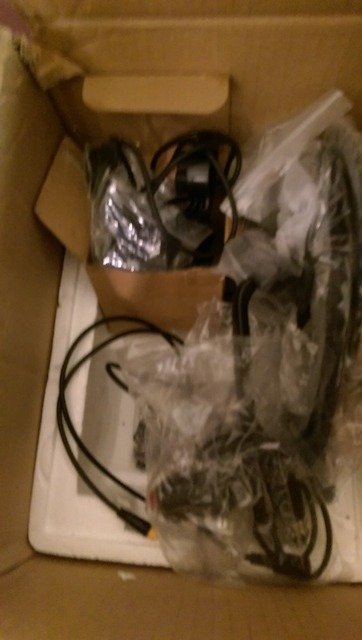
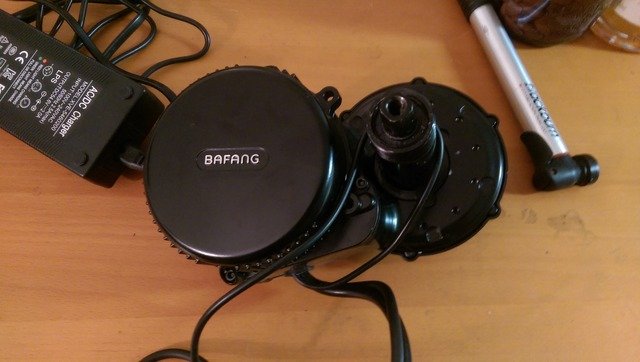
I also purchased a "Shark" LiFePO4 battery at a discount from them. That completed my drivetrain needs. I wanted LiFePO4 over standard LiPO as it is more resistant to heat problems and can get higher voltage in series than LiPO. You pay more for the peace of mind, And I got a deal on mine. 11.7AH 52 Volts for $400.00
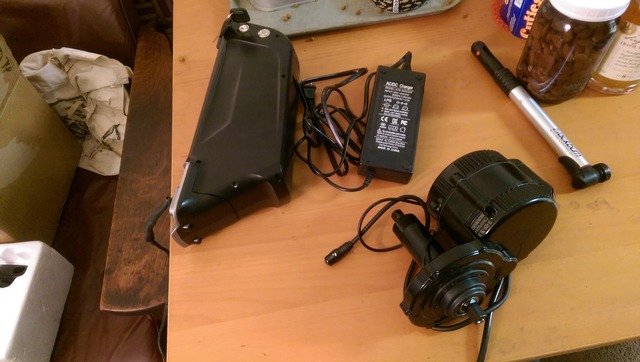
Next was a bike I got on Craigslist.
I found a 7 year old Trek 3700 for $75.00. I had budgeted $200.00 here, so was very happy to get a gently used bike with upgraded forks, Upgraded rims, upgraded gearing (7-8 Speed rear), upgraded Riser bars and Carbon stem. Just the forks run $280.00. The seller had several very nice bikes in his garage, and he told me he rode this for 6 months, and moved up to full suspension. WINNING!
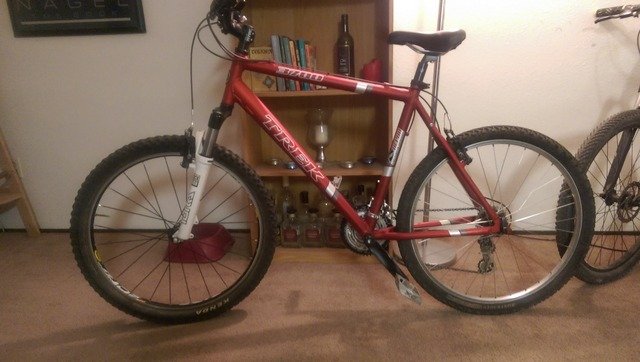
Oh that pesky math
Let's do this:
Bike $ 75.00
Bafang Kit $ 545.00
Shark Battery $ 400.00 X
Total $1020.00
Next up: Putting it all together Stay tuned for Part 3.
Disclosure. I am not affiliated in any way with any companies, products, websites or agents of any companies, products, or websites I have mentioned in the above Article, and I do not endorse them in any way. That being said, unless I "neg ed" them, they are likely worth checking out yourself.
Unless otherwise noted, All photos are the Authors, and are not to be used without permission.
If I would've found this blog sooner I would've given it a full 100% upvote. Great blog and I'm looking forward to part 3.
I am now following you.
Thanks! I'll get it together this weekend. Content is where it's at, right?
Seriously considering a build for commuting. We only need a "2nd car" a few days a month, and living in Southern California the weather is almost always perfect bike riding weather... Following :)
Well, You know I will come help you build one...